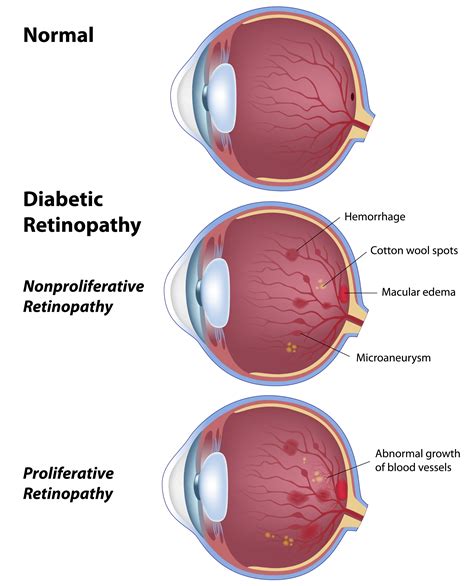Understanding Diabetic Retinopathy
Diabetic Retinopathy FAQ
What causes diabetic retinopathy?
Diabetic retinopathy is caused by high blood sugar due to diabetes. Over time, having too much sugar in your blood can damage your retina — the part of your eye that detects light and sends signals to your brain through a nerve in the back of your eye (optic nerve). Diabetes damages blood vessels all over the body.
When is diabetic retinopathy treated?
Diabetic retinopathy usually only requires specific treatment when it reaches an advanced stage and there's a risk to your vision. It's typically offered if diabetic eye screening detects stage 3 (proliferative) retinopathy, or if you have symptoms caused by diabetic maculopathy. At all stages, managing your diabetes is crucial.
What is diabetes-related retinopathy?
Diabetes-related retinopathy is an eye disease that affects the retina. Anyone with diabetes can develop this condition. Without treatment, diabetes-related retinopathy can lead to vision loss or blindness. But with the right care, you can prevent vision loss and stop disease progression.
How does diabetic retinopathy affect both eyes?
Diabetic retinopathy symptoms usually affect both eyes. Drops will be put in your eye to dilate (widen) your pupil. This allows your ophthalmologist to look through a special lens to see the inside of your eye. Your doctor may do optical coherence tomography (OCT) to look closely at the retina.
What is diabetic retinopathy?
Diabetic retinopathy is an eye disease that people living with diabetes are more at risk of developing. If your blood glucose (sugar) levels and blood pressure are consistently high, you can seriously damage your blood vessels.
Can diabetic retinopathy cause blindness?
Diabetic retinopathy is a complication of diabetes, caused by high blood sugar levels damaging the back of the eye (retina). It can cause blindness if left undiagnosed and untreated. However, it usually takes several years for diabetic retinopathy to reach a stage where it could threaten your sight.
How does diabetic retinopathy affect the retina?
In the early stages of diabetic retinopathy, the walls of the blood vessels in your retina weaken. Tiny bulges protrude from the vessel walls, sometimes leaking or oozing fluid and blood into the retina. Tissues in the retina may swell, producing white spots in the retina.
Diabetic Retinopathy References
If you want to know more about Diabetic Retinopathy, consider exploring links below:
What Is Diabetic Retinopathy
- https://www.nhs.uk/conditions/diabetic-retinopathy/
- https://www.diabetes.org.uk/guide-to-diabetes/complications/retinopathy
- https://www.mayoclinic.org/diseases-conditions/diabetic-retinopathy/symptoms-causes/syc-20371611
- https://www.nei.nih.gov/learn-about-eye-health/eye-conditions-and-diseases/diabetic-retinopathy
- https://www.aao.org/eye-health/diseases/what-is-diabetic-retinopathy
- https://patient.info/diabetes/diabetic-retinopathy
- https://www.nhsinform.scot/illnesses-and-conditions/diabetes/diabetic-retinopathy
- https://eyewiki.aao.org/Diabetic_Retinopathy
- https://my.clevelandclinic.org/health/diseases/8591-diabetic-retinopathy
Diabetic Retinopathy Information
Explore Related Topics
Enhancing Diabetic Retinopathy Treatment with Nanotechnology: A Brighter Future?
Can nanotechnology innovations revolutionize the treatment of diabetic retinopathy?
